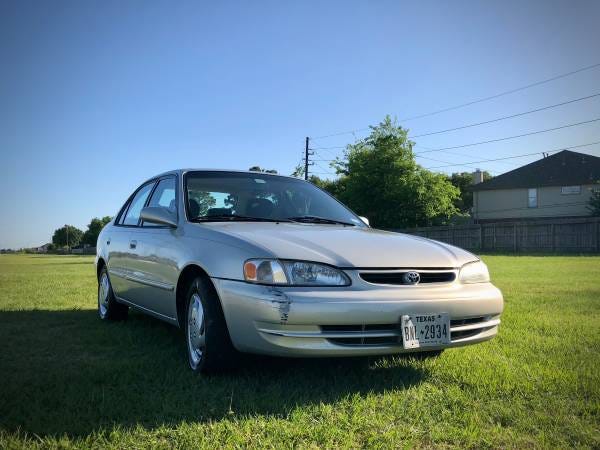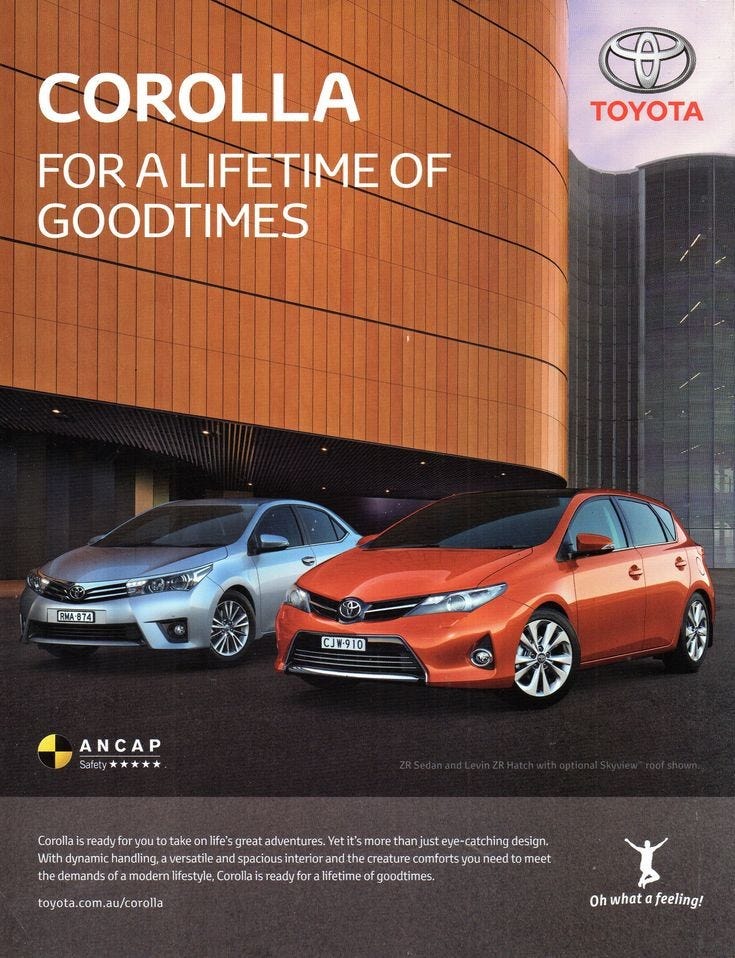Bring me a 1999 Toyota Corolla
A top creativity tip: take off those rose-tinted shades and embrace the negative.
One of my favourite ways to solve a creative problem is to start with a weakness.
In his excellent book “A Self-Help Guide for Copywriters”, Dan Nelken calls this ‘embracing your dirt’ or ‘sacking yourself’. The idea he describes is to steal your opposition’s thunder by using something that sucks about your brand before someone else does.
I won’t go into much detail here because really you should just buy Dan’s book, but to pick an example he didn’t, here’s one example of DDB’s classic Avis campaign “We Try Harder”:
Much has been written about this campaign, but the gist is “smart, brave, successful”. Smart idea from the agency, brave of the client to run with it, and wildly successful by all accounts. And it all started from a weakness: Avis was being beaten by Hertz. According to this article in Slate:
In 1962, Avis was in search of a new advertising campaign. Since its inception, the car rental company had trailed behind the market leader, Hertz. So the ad agency Doyle Dane Bernbach decided to embrace Avis’ second-place status as a sneaky way to tout the brand’s customer service. “When you’re only No. 2, you try harder,” went the new tagline. “Or else.”
The “We Try Harder” ads were an instant hit. Within a year, Avis went from losing $3.2 million to earning $1.2 million—the first time it had been profitable in more than a decade. From 1963 to 1966, as Hertz ignored the Avis campaign, the market-share percentage gap between the two brands shrunk from 61–29 to 49–36. Terrified Hertz executives projected that by 1968 Avis might need a new ad campaign—because it would no longer be No. 2."
A more recent example is Barbie, in which Mattel [eventually] embraced the idea of being the butt of the joke [some of the time]. It’s charming, disarming and - again - wildly successful. The film couldn’t have worked if Mattel insisted on being an untouchable monolith of unimpeachable quality.
Start off on the wrong foot.
While this is a great way to protect your brand (or your client’s brand) from being attacked or undermined, I reckon it’s a useful technique to use any time you’re faced with a brief.
Weaknesses can be real or perceived. If you’re working with a client, it’s probably an easier sell to talk about perceived negatives because the semantics of that phrase are an easier pill to swallow - “it’s just what people think, but they’re wrong!”.
Of course, unpacking that rationale is a whole future newsletter entry. The risk of talking about perceived weakness is that it becomes an excuse to talk about your strengths, a bit like going to a job interview and saying your weakness is your appetite for success.
Instead, I think it’s important to be realistic and honest about your brand or product’s weaknesses and flaws. The truth always offers the most fertile ground. Here’s my favourite example: the slightly-famous Craigslist ad for a Toyota Corolla, which concludes with the following:
"Let's face the facts, this car isn't going to win any beauty contests, but neither are you. Stop lying to yourself and stop lying to your wife. This isn't the car you want, it's the car you deserve: The fucking 1999 Toyota Corolla.”
There’s simply no way that ad came from the core idea that a Toyota Corolla is a prudent choice. It’s a masterpiece, which almost certainly germinated from a weakness: the 1999 Toyota Corolla is a very boring car.
Honesty is what gives this seller the license to talk about their product’s benefits. Suddenly all those claims about reliability, dependability and fuss-free ownership have real meaning. There's a real insight into what some people want, expect and need from a car. It clearly talks to one audience who wants something that gets them from A to B, while turning away another audience that wants luxury bells and whistles.
Contrast it with a real ad for a new Toyota Corolla, which quite possibly has the same core truth: a car that will last a long time.
I’m not saying going negative works for everything, or all the time. I'm not even saying Toyota's ad is all that bad.
But going negative is a way of breaking the boring pattern of looking only at positives and benefits. It can save your work from being boring, and bring you into a much closer conversation with your audience.
Of course, a lot of businesses really want everyone to wear rose-tinted specs when talking about their products, so this idea might be limited to your brainstorming. It’s not easy to accept a negative, and not many brands seem to go for the idea in their campaigns.
But I wish they would. Because sometimes starting with weaknesses can bring your strengths into sharp relief.





